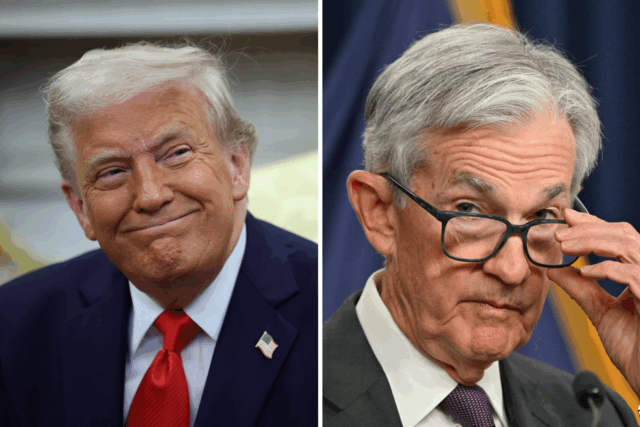
Wall Street took a steep dive on Monday, with all three major U.S. stock indexes falling by more than 1%, after President Donald Trump escalated his criticism of Federal Reserve Chair Jerome Powell. The sharp losses reflect growing investor anxiety about the Fed’s independence and mounting tensions from the ongoing trade war.
The Dow Jones Industrial Average shed over 400 points, or 1.2%, while the S&P 500 dropped 1.3%, and the Nasdaq Composite fell 1.5%, marking one of the worst single-day performances for the market in recent months.
Trump Intensifies Pressure on Powell
Markets were rattled after Trump doubled down on his verbal attacks against Powell, stating late last week that the Fed chair’s “termination cannot come fast enough.” The President’s comments followed the Fed’s recent decision to keep interest rates steady despite pressure from the White House for aggressive rate cuts.
The tension took a more serious turn when White House economic adviser Kevin Hassett told reporters on Friday that the administration is exploring whether the president has legal authority to fire Powell. The suggestion sent shockwaves through financial circles, as it challenges a long-standing norm that the U.S. central bank should operate independently from political influence.
Investor Confidence Shaken
The prospect of political interference in the Federal Reserve’s decision-making process shook investor confidence. Analysts warn that undermining the Fed’s autonomy could damage the credibility of U.S. monetary policy and deter both domestic and global investors.
“The Fed’s credibility is paramount to financial stability,” said Lisa Abrams, chief market strategist at GoldRock Investments. “The mere hint of a sitting president trying to remove the central bank’s chair sends a deeply unsettling message to markets.”
Wall Street has long regarded the Federal Reserve’s independence as a bedrock principle of the U.S. financial system. Any disruption to that principle could lead to increased volatility, higher borrowing costs, and a weakened dollar.
Trade War Adds Fuel to Fire
Investors are also contending with renewed concerns over the U.S.-China trade war. Over the weekend, China announced retaliatory tariffs on $50 billion worth of U.S. goods, following Washington’s latest round of tariff hikes. The growing standoff between the two global superpowers has injected further uncertainty into markets already on edge.
“The trade war was already creating turbulence,” said Ellen Vargas, a senior analyst at MarketSpan Global. “But now with the Fed in the political crosshairs, the risk factor has multiplied.”
Financial Sector and Tech Take Biggest Hits
Bank stocks, which are particularly sensitive to interest rate expectations and regulatory policy, were among the hardest hit. JPMorgan Chase, Bank of America, and Citigroup all fell more than 2% on the day. Tech giants like Apple, Amazon, and Microsoft also saw declines amid the broader market sell-off, dragged down by worries over global growth and reduced consumer spending power.
What’s Next?
While Trump’s ability to actually fire the Fed Chair remains legally uncertain—many legal scholars argue it would require proving “cause”—the mere suggestion has created a sense of unpredictability.
Jerome Powell, who was appointed by Trump himself in 2018, has largely remained silent on the political firestorm. The Fed is scheduled to meet again next month, with investors eagerly watching for signs of how it will respond to both inflation data and political pressure.
In the meantime, Wall Street is bracing for further volatility. The CBOE Volatility Index (VIX), often called the market’s “fear gauge,” surged by 15% on Monday, reflecting a spike in investor nervousness.
Conclusion
With economic headwinds gathering—from political interference in monetary policy to escalating trade disputes—investors are facing a complex and uncertain landscape. The question now is not only what the Federal Reserve will do next, but whether it will be allowed to act freely without political constraint.
As one trader put it on the floor of the NYSE, “Markets don’t like surprises—and this one came straight from the Oval Office.”



